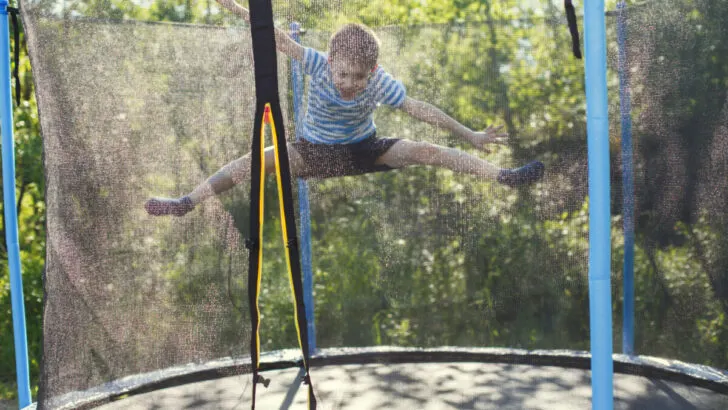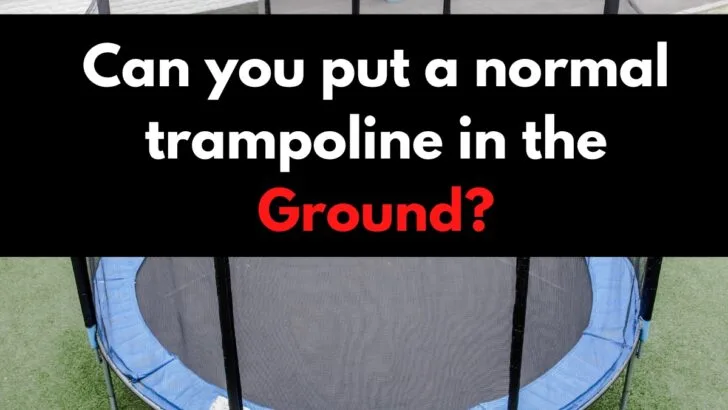Many people dig holes to put their trampolines in when they set them up. Can you put a normal trampoline in the ground?
You can put a normal trampoline in the ground. These trampolines are also more convenient because you can step onto them and not climb up a few feet.
I have set up a trampoline by myself before and while it can be done, it’s too much of a hassle if you’ve never done it before. Calling a professional is a better idea if you want your trampoline in the ground. Only do it yourself if you are familiar with the equipment.
Can You Put a Normal Trampoline in the Ground?
You can put a normal trampoline in the ground. However, you may have to check your local laws. It might not be legal for you to dig a hole that size in your area, or you may need a permit to do so.
If you dig a hole for your trampoline without knowing what your doing, many things can go wrong. For example, the ground can collapse over time. You may need to build a retaining wall to prevent this.
It is a fair bit of work and planning to do it yourself. You might want to call a professional if you don’t want to do a relatively big job. There are ways to make it work.
Are Trampolines Dangerous?
Trampolines can lead to injuries, especially if they aren’t set up the right way. Many people break bones on trampolines. However, they are still great fun and exercise.
Use your best judgment and decide whether you want a trampoline at your home.
Your kids might have fun on the trampoline for years and never get hurt, but they are not one of the safer types of play equipment.
Trampolines and Safety
Trampolines are great for exercise. They get your heart rate up and strengthen your muscles. However, you can hurt your legs, arms, head, or neck.
Very young children (under 6) should not be on a trampoline. Kids between 6 and 10 need to be supervised. Kids over 10 are less likely to get hurt and should be able to use a trampoline unsupervised.
Teenagers and adults are less likely to get seriously hurt than kids. If a kid gets hurt, they might break a bone, but an adult or teen might only sprain it.
Challenges in Setting Up a Trampoline
There are a few challenges in setting up a trampoline at your home, including:
The Ground Collapses Over Time
Over time, the ground will collapse, bringing the trampoline closer to the ground. This makes it possible for someone to hit the ground when bouncing up high and coming down, possibly leading to injury. A retaining wall adds to the time and money you spend on the project.
Drainage
The hole you dig in the ground will need a way to drain, and maybe a pump too. This is another reason to hire a professional.
How to Place a Trampoline
Usually, people get a professional to do this. It is fairly expensive (very roughly $1500) and only takes a day or two.
If you are confident that you can do it yourself, you might save $1000 that way. You might be able to rent the equipment for $500 and do the work yourself.
How to Put a Trampoline on the Ground
First, notify your city that you are going to dig in the ground – it might be illegal otherwise. Plan out the hole carefully before you dig. Make sure you leave enough room or you will have to make time-consuming adjustments.

Make sure that the weather is good. You don’t want it to start raining as soon as you start digging.
Measuring the Hole
If the trampoline is square or rectangular, measuring the hole is easy – just use a measuring tape. If the trampoline is circular, it will be a bit harder. Measure the circumference and use that to mark a circular hole.
Leave at least 3 inches around the entire edge on all sides. This will allow water to drain off of the trampoline plus give you space for a pump if you need one.
Use Heavy Equipment
Possibly, you could dig the entire hole only with a shovel. However, that is a lot of work. Renting equipment is a better idea.
Soil Stability
Even if the soil seems strong and stable at the top, it might not be farther down. You might finish digging the hole and realize that the soil is too unstable to work.
Thankfully, you can solve that problem by building a retaining wall. This takes time and materials, but it will make it work even if the ground is nowhere near stable enough.
Add a Pump/Drainage
With no drainage, water will accumulate on top of the trampoline and eventually damage it. There needs to be room around the sides for the water to drain away.
You probably also need a sump pump. This is tricky to do yourself, so it’s best to hire a professional. Make sure you leave enough room around your trampoline for the pipes.
Insert the Trampoline
After you are finished digging the hole and installing the pipes, you can insert your trampoline. Make sure you get it right in the center so that there is space around the entire trampoline.
Finally, you replace some of the dirt to hold the trampoline in place. The grass will gradually grow back over the ground and strengthen it.
After you are done, you might add padding around the trampoline (to prevent injuries) or add grass or other plants to improve the appearance.
Key Takeaways to Putting a Normal Trampoline in the Ground
You can dig a regular trampoline into the ground. It works with any trampoline and not only certain kinds.
It’s best to hire a professional to do the job unless you are familiar with the equipment.
Young children should not be on a trampoline without supervision, and very young children should not play on it at all.
You will need drainage if you dig your trampoline into the ground.


